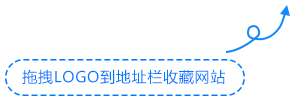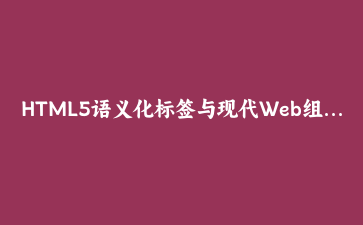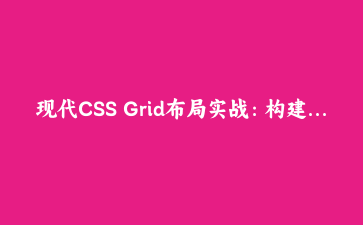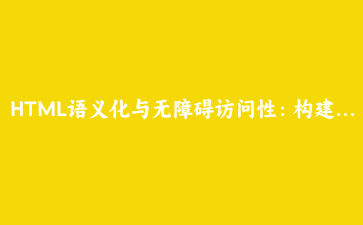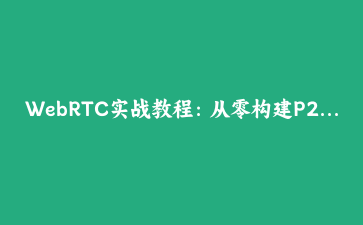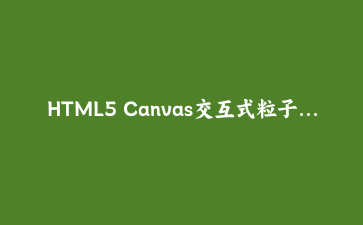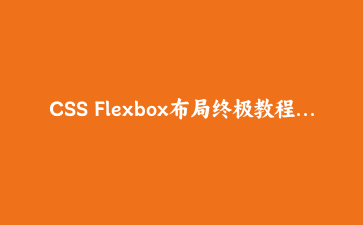深入探索HTML5语义化标签的正确用法,并结合现代Web组件技术构建可复用的UI组件
HTML5语义化标签深度解析
为什么语义化标签如此重要?
语义化HTML不仅提升了代码的可读性,更重要的是为辅助技术提供了清晰的文档结构,改善了网站的可访问性。
<!-- 传统div布局 -->
<div class="header">
<div class="nav">...</div>
</div>
<div class="main">
<div class="article">...</div>
</div>
<!-- 语义化HTML5布局 -->
<header>
<nav>...</nav>
</header>
<main>
<article>...</article>
</main>常用语义化标签及其应用场景
<section>- 定义文档中的节,通常包含标题和内容
<article>- 独立的自包含内容,如博客文章、新闻故事
<aside>- 与主要内容间接相关的内容,如侧边栏、引用
<figure> 和 <figcaption>- 媒体内容及其标题的语义化组合
<time>- 机器可读的时间日期信息
现代Web组件技术详解
Custom Elements:自定义HTML元素
Custom Elements允许开发者创建自定义的、可重用的HTML元素。
class UserCard extends HTMLElement {
constructor() {
super();
this.attachShadow({ mode: 'open' });
}
connectedCallback() {
this.render();
}
static get observedAttributes() {
return ['name', 'avatar', 'email'];
}
attributeChangedCallback(name, oldValue, newValue) {
this.render();
}
render() {
this.shadowRoot.innerHTML = `
<div class="user-card">
<img src="${this.getAttribute('avatar')}"
alt="${this.getAttribute('name')}">
<div class="user-info">
<h3>${this.getAttribute('name')}</h3>
<p>${this.getAttribute('email')}</p>
</div>
</div>
`;
}
}
customElements.define('user-card', UserCard);Shadow DOM:封装样式和行为
Shadow DOM提供了样式和标记的封装,避免与外部样式冲突。
class StyledButton extends HTMLElement {
constructor() {
super();
const shadow = this.attachShadow({ mode: 'open' });
const style = document.createElement('style');
style.textContent = `
button {
background: linear-gradient(45deg, #667eea, #764ba2);
border: none;
border-radius: 25px;
color: white;
padding: 12px 24px;
font-size: 16px;
cursor: pointer;
transition: transform 0.2s;
}
button:hover {
transform: translateY(-2px);
}
`;
const button = document.createElement('button');
button.innerHTML = '<slot>默认按钮</slot>';
shadow.appendChild(style);
shadow.appendChild(button);
}
}
customElements.define('styled-button', StyledButton);实战案例:构建可复用的产品卡片组件
组件需求分析
- 显示产品图片、标题、描述和价格
- 支持添加到购物车功能
- 响应式设计,适配不同屏幕尺寸
- 良好的可访问性支持
HTML结构设计
<product-card
sku="P001"
name="无线蓝牙耳机"
price="299"
image="/images/headphones.jpg"
description="高保真音质,舒适佩戴">
</product-card>JavaScript组件实现
class ProductCard extends HTMLElement {
constructor() {
super();
this.attachShadow({ mode: 'open' });
this.render();
}
static get observedAttributes() {
return ['sku', 'name', 'price', 'image', 'description'];
}
attributeChangedCallback(name, oldValue, newValue) {
if (oldValue !== newValue) {
this.render();
}
}
render() {
this.shadowRoot.innerHTML = `
<article class="product-card" role="article">
<figure class="product-image">
<img src="${this.getAttribute('image')}"
alt="${this.getAttribute('name')}"
loading="lazy">
</figure>
<div class="product-info">
<header>
<h3>${this.getAttribute('name')}</h3>
</header>
<p class="product-description">
${this.getAttribute('description')}
</p>
<div class="product-price">
<span class="price">¥${this.getAttribute('price')}</span>
</div>
<footer class="product-actions">
<button class="add-to-cart"
aria-label="添加到购物车">
加入购物车
</button>
</footer>
</div>
</article>
<style>
.product-card {
border: 1px solid #e0e0e0;
border-radius: 8px;
overflow: hidden;
background: white;
transition: box-shadow 0.3s ease;
}
.product-card:hover {
box-shadow: 0 4px 12px rgba(0,0,0,0.1);
}
.product-image img {
width: 100%;
height: 200px;
object-fit: cover;
}
.product-info {
padding: 1rem;
}
.product-info h3 {
margin: 0 0 0.5rem 0;
font-size: 1.2rem;
}
.product-description {
color: #666;
margin: 0.5rem 0;
}
.product-price {
margin: 1rem 0;
}
.price {
font-size: 1.5rem;
font-weight: bold;
color: #e74c3c;
}
.add-to-cart {
width: 100%;
padding: 0.75rem;
background: #3498db;
color: white;
border: none;
border-radius: 4px;
cursor: pointer;
font-size: 1rem;
}
.add-to-cart:hover {
background: #2980b9;
}
</style>
`;
this.shadowRoot.querySelector('.add-to-cart')
.addEventListener('click', () => this.addToCart());
}
addToCart() {
const productData = {
sku: this.getAttribute('sku'),
name: this.getAttribute('name'),
price: this.getAttribute('price')
};
const event = new CustomEvent('product-added', {
detail: productData,
bubbles: true
});
this.dispatchEvent(event);
}
}
customElements.define('product-card', ProductCard);组件使用示例
<!-- 在页面中使用产品卡片组件 -->
<section class="products-grid">
<product-card
sku="P001"
name="无线蓝牙耳机"
price="299"
image="/images/headphones.jpg"
description="高保真音质,舒适佩戴">
</product-card>
<product-card
sku="P002"
name="智能手表"
price="599"
image="/images/smartwatch.jpg"
description="健康监测,运动追踪">
</product-card>
</section>
<script>
// 监听添加到购物车事件
document.addEventListener('product-added', (event) => {
console.log('产品已添加到购物车:', event.detail);
// 更新购物车UI
updateCartUI(event.detail);
});
</script>最佳实践与性能优化
可访问性考虑
- 为自定义元素添加适当的ARIA属性
- 确保键盘导航支持
- 提供有意义的焦点指示器
- 使用语义化的HTML结构
性能优化建议
- 使用
loading="lazy"延迟加载图片 - 避免在Shadow DOM中重复定义相同的样式
- 合理使用
connectedCallback和disconnectedCallback - 考虑使用模板引擎或lit-html进行高效渲染
浏览器兼容性处理
// 检测浏览器是否支持Web Components
if (!('customElements' in window)) {
// 加载polyfill或提供降级方案
const script = document.createElement('script');
script.src = 'https://unpkg.com/@webcomponents/webcomponentsjs@2.6.0/webcomponents-bundle.js';
document.head.appendChild(script);
}总结
HTML5语义化标签与现代Web组件技术的结合,为前端开发带来了革命性的变化。通过语义化标签,我们能够创建更加结构清晰、可访问性更好的网页;而Web组件则提供了强大的封装和复用能力。掌握这些技术,将帮助你构建更加现代化、可维护的Web应用。
在实际项目中,建议根据具体需求选择合适的方案:对于简单的UI组件,可以使用纯语义化HTML;对于复杂的、需要高度复用的组件,Web组件是更好的选择。记住,技术选择应该服务于项目需求和用户体验。
// 注册Web Components的示例代码
if (typeof ProductCard === ‘undefined’) {
console.warn(‘ProductCard组件未定义,请在支持Web Components的环境中运行’);
}
